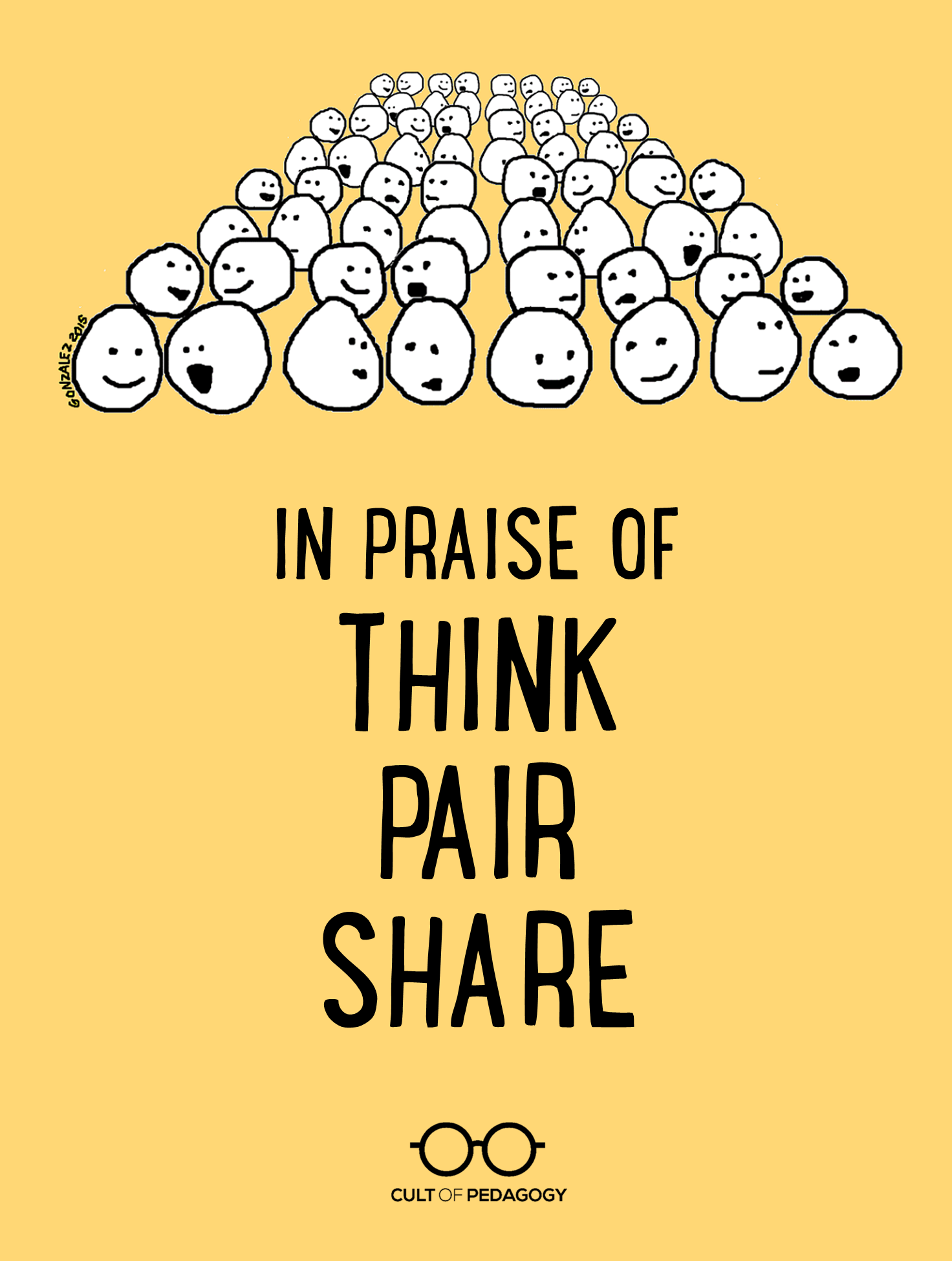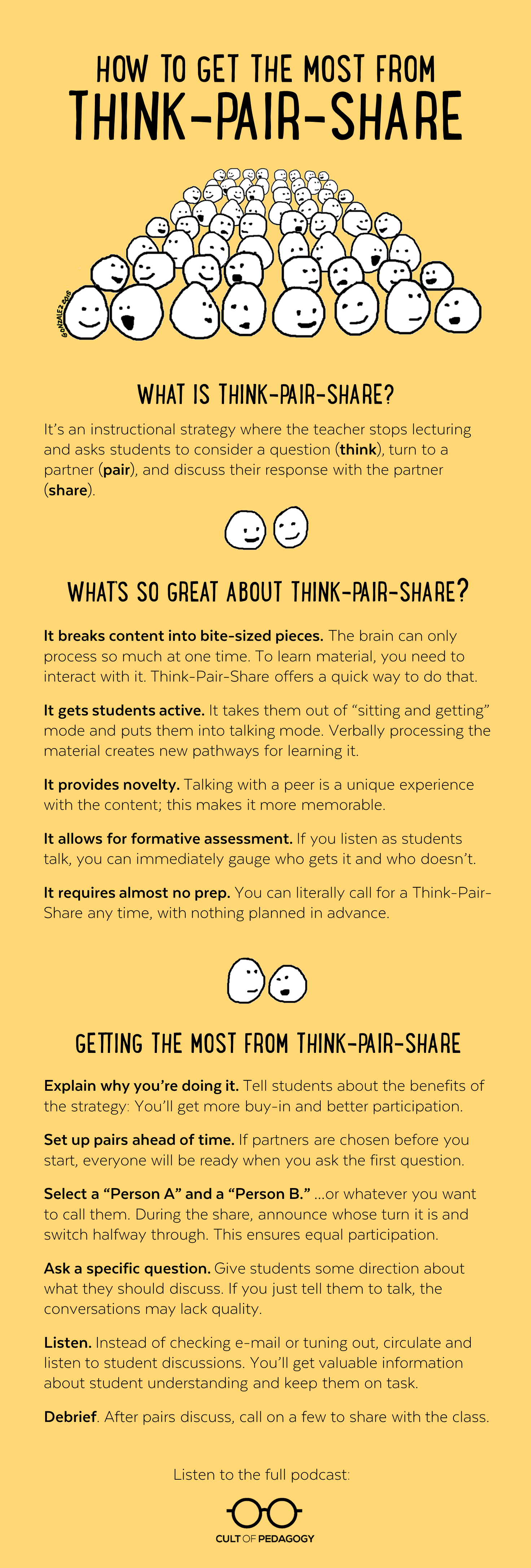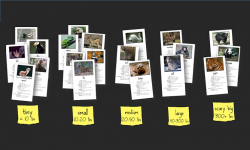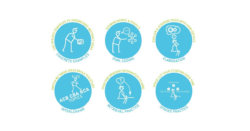
Listen to this post as a podcast:
Think-pair-share has gotten a bad rap. In July of 2013, just as I was starting this blog, I read a snarky piece where the author slammed administrators’ use of the strategy in faculty meetings. The piece got a lot of attention, lots of thumbs-up, but I felt kind of indignant.
Because I LOVE think-pair-share. It’s as flexible and at-the-ready as a 16-year-old gymnast on Red Bull. It’s the first strategy I explain to people who have no teacher training but have found themselves in a position to teach.
I do, however, think there’s a right way and a wrong way to use it. So for the sake of celebrating think-pair-share, the Little Strategy That Could, and to share some best practices with this strategy, I made it the focus of my latest podcast. You can listen, read the transcript, or read the infographic that summarizes it all.

Join my mailing list and never miss another post. You’ll get weekly tips, tools, and inspiration — in quick, bite-sized packages — all geared toward making your teaching more effective and joyful. To thank you, I’ll send you a free copy of my new e-booklet, 20 Ways to Cut Your Grading Time in Half. I look forward to getting to know you better!





I love think-pair-share! I think when adults claim not to love it, it is because the group leader has not explained its value. As you explain above, the teacher (group leader; administrator; principal; department chair; “boss”) has to explain the value of the think-pair-share process. Even adults have to be “trained” to cooperate, just like kids! You can’t expect anyone to know what you expectations are until you’ve explained them. It is like giving a test before teaching the material and then complaining about everyone failing.
I totally agree — I guess most strategies are like that, huh?
I loved it so much it has helped me
So just before I posted this, I did a Google search for this strategy and discovered that David Ginsburg over at Education Week Teacher had just done a wonderful post on the same thing not two weeks earlier. His article includes a tip I completely forgot to add here, but feel VERY strongly about: It’s very useful to have students write down their thoughts before they share with a partner. That would make it Think-Write-Pair-Share. Adding this step really helps students process their own thoughts before being influenced by someone else. Click here to read his post on think-pair-share.
Thanks for a great website and interesting articles, Jennifer.
Kagan Cooperative Learning have designed many “structures” for cooperative learning that really work well and that can be easily incorporated into every lesson – no need for special “cooperativelearning” lessons.
Have you heard of them? Check out there website – easy to find via our friend Google…
I am based in Cape Town, South Africa, and am accredited by Kagan to train and coach school teachers here. The Kagan structures work incredibly well in South African schools – if they can work here, they can work anywhere.
Thanks for a great website and keep up the good work.
Wilfred,
Thanks so much for sharing Kagan structures. This is a great resource for cooperative learning strategies.
This is kind of what I was thinking. I teach using team-based learning. To prepare to go into depth on a topic, I do a mini-application exercise. I give them a forced-choice question to answer in their teams. They have 10 minutes to answer and find one source that supports their answer. They have complete and submit a Google form before the 10 minutes is up. At the end of the 10 minutes, I gather the responses from the forms into a Slides Deck (using Autocrat). We go over each team’s submission and ask them to elaborate. This is more of a think-group-write-share.
Journey North features Instructional Activities that we embed into our lessons. Here’s our take: Two-Word Reflection & Think-Ink-Pair-Share http://www.learner.org/jnorth/tm/InstrucStrat36.html
http://www.learner.org/jnorth/
Everyone, definitely take a look at the above resource — two really cool additions to the basics that add a nice twist!
Thank you very much madam for these valuable information, I m going to use them for my next classes. They benefit students from bracing the class information, and to switch from the receive-mode to the send-mode.
Thank you! Thank you Jennifer! I’m new to your site, referred my a fellow classmate. I’m teaching my own class for the first time as an adjunct so this information is indispensable.
I really share this idea! a great example of autonomous learning!
Thank you for your post. I share this strategy with teaches k-12 and more importantly it is used in all of my PD sessions. I have a hard time going more than 10-15 minutes without having particpants turn and talk, etc. trying to model and practice strategies which I recommend . I would second the big idea of writing down first or at least give 3-5 seconds ( or longer) wait time. A very wise principal brought the ” wait time” to my attention.
I use it with my library classes because we have such limited time with the kids, but we still want to assess what they know and what and how they are thinking and give everybody a chance to participate.
Thanks, Jennifer. I originated TPS in 1978 as a way to help student teachers survive. It may now be the most used cooperative discussion technique in USA and in some countries of the world. Lynda Tredway sent me a link to you. I will stay in touch Your treatment is good. Frank
Hi Frank! It’s great to have you here! I’m thrilled to have your blessing. Thank you!
Hi Mr. Lyman! I just gave you a shout out below, then saw you had commented here! You were my and my sister Mary’s supervisor in HOCO in the early 90s- I taught art and she elementary. We both have very fond memories of working with you, and your wonderful way of connecting with us all. Thank you for all that you have done for our teachers and schools!
I use think-write-pair-share a lot with my EFL students here in Japan. It’s a good strategy for Language learners to practice meaning-focused output. It gives them time to process the language and get their ideas down on paper, as well as providing valuable opportunities for repetition when they share their answers with more than one partner and with the class. Love it.
Another advantage of Think, Write, Pair, Share, is that is increases the confidence of students who are reluctant to speak in front of the class. After the time provided to collect and articulate their ideas to their partner, and possibly get positive feedback, it is much easier for them to express their ideas to the entire class. They aren’t put on the spot to generate an answer immediately, as they might be during a teacher-led discussion.
And during the pair-share segment, the teacher can listen in and encourage a quieter kid. “That’s a good point, Jilly. Would you mind sharing that with the class when we get back together?”
Face it, teachers are often the WORST behaved in meetings. If their students acted in class the way teachers act in meetings, they would flip out. Most teachers I have been around groan instantly when asked to do anything other than “sit and get” in PD or meetings.
Back to T\P\S… Way back in my master’s program, I discovered a strategy called quick-write journals. Usually I pair those with a think pair share type strategy.
I’m speaking as a student who often has bad luck with group work in class. For the pairing off step, I think the best idea is to group students systematically (count off, person next to them, etc). This way, no one gets left out, and students grow by talking to someone they wouldn’t choose to talk to.
I Love the fact that getting kids to talk about the content is the goal. We have to allow students time to process ans make meaning. The real danger in this strategy is one person can hog all the airtime and one student can essentially hide. Using a timed pair share where each student has equal time ensures both in the pair are engaged. Only by ensuring the equal participation do we ensure equity in the classroom. Some kids hogging and some kids hiding equals inequity. Some kids will learn and some kids will hide.
I know this is an older podcast, but is a transcript still available? I am having difficulty finding it.
Thank you!!
The transcript for Episode 10: In Praise of the Think-Pair-Share is available here.
Just before my first year of teaching (30 years ago) I got to attend some Kagan Cooperative Learning training. Think-Pair-Share was probably my biggest takeaway. Then we moved to North Carolina and everyone here seems to think it’s Think-Pair Share-Share Out. It drives me crazy. Share out? What they mean is share with the group, but it’s just not right. There a lots of colloquialisms that I don’t mind, or even use, but Share Out is NOT one of them.
Think-pair-share is great if you need to check in on the fly, It may be a little uncomfortable at the beginning of the year since they don’t know each other, but this would be a great way for them to get to know each other. I may even create an activity where this strategy is used the first week of school where they can share out about each other.
A great piece! Thanks for sharing. In my experience, the success of the strategy is dependable on students / receivers understand the strategy’s value.
I’m a newly graduated teacher, and I love using “think, pair, share”. It tells me immediately if students are understanding what I’ve taught When I was a student teacher I really utilized many strategies we learned in university. The kids were engaged, and even now I relish the thought of how I will be teaching my own class one day. For now I’m a TTOC but, one day…
Thank you for defending T-P-S! I first learned it as an undergrad in the 90’s, and I’ve seen it used at every level in many states since then, very successfully. And want to give a shout out to my student teaching supervisor at the University of Maryland who invented Think-Pair-Share – Frank Lyman! He was a funny, creative and brilliant man and educator!
Hi Jeniffer,
I loved all the six strategies and some were very new to me. I am so glad that I visited your website and learned new strategies that I can implement in my teaching.
My favorite is the retrieval practice and the Dual Code.
Best wishes,
Chaya
Thanks so much!
Hi Chaya,
I’ll be sure to share this with Jenn – she’ll be so happy to hear you found value in the post!
Love the “Teach, OK” and think pair share has always been a favorite tool to use. Great ideas.
Are there any other strategies besides think-pair and share?
Hi Talisca,
Here’s a link to another one of Jenn’s posts on discussion strategies: The Big List of Class Discussion Strategies. Hope you find this helpful!